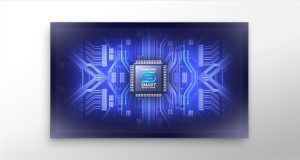System-on-Chip (SoC) is an integrated digital signage solution where media player hardware is embedded within a display, eliminating the need for third-party, external media players. These external media players are the commercial equivalent of consumer products such as Roku, Chromecast and Amazon Fire.
Initial System-on-Chip Products Had Limited Capabilities
First generation SoC products from Samsung and Sony launched in 2013, followed by second generation displays and the entrance of LG into the market in 2014. First and second generation products had minimal processing and graphics power, which restricted capabilities of playback of images and basic video.
Content creators and software developers often faced a substantial learning curve when required to use proprietary operating systems (e.g., Samsung Tizen OS, LG WebOS). Finally, adoption was hindered by skepticism about long-term commitment of manufacturers to what will always be for them a relatively niche product.
Subsequent generations have addressed some of the issues encountered by early adopters. Enhanced hardware have greatly improved the functionality and flexibility of SoC displays.
New entrants into the market (Panasonic, Philips, Sharp, Toshiba, etc.) have adopted Android as a standard, and Samsung and LG have made their operating systems more developer-friendly.
The fact remains, however, that Android is a consumer-grade operating system and the proprietary OS’s are derivatives of consumer TV platforms. They originated primarily from the world of streaming, and did not have a lot of focus on software development. The core hardware is good, but the software ecosystem is changing all the time, and that makes life difficult for end-users and developers.
What the industry needs are very stable API’s because so many software developers are developing on these platforms. When the software changes with every new version of the consumer TV models, development is quite difficult.
System-on-Chip Now Offers Some Advantages
The primary selling point for SoC is that the upfront cost is approximately 25-40% lower than comparable solutions. Users also typically experience a reduction in hardware support expense due to fewer points of failure. Power consumption is usually lower as an integrated design improves energy efficiency. In addition, since there is no need for configuration; the installation process is straightforward and requires less technical expertise.
Most display manufacturers require screens to have constant Internet access both to stream data and to download software updates. While this connectivity is convenient, it also creates a potential security concern for corporations with large installations consisting of hundreds of displays.
External Hardware Remains Essential in Certain Situations
Despite recent improvements, SoC devices continue to face some limitations in their ability to support the breadth of features needed for many types of digital signage projects. Consequently, external media player solutions remain the solution of choice for businesses that would like to ensure seamless transitions between media content, complex video layering and HTML rendering, or synchronization between multiple displays.
The primary advantage of dedicated external media players is the breadth of the software functionality that is included with the offering.
External hardware also provides flexibility for a wide variety of uses including touch screens and complicated display solutions and / or video walls with a range of display sizes mounted at various angles. An additional consideration for many buyers is that it is easier to upgrade external hardware, which helps to “future-proof” the display and provides more flexibility going forward as buyers are not locked into a specific product ecosystem.
Another Option for All-in-One
A different type of integrated solution is gaining momentum in the industry. Displays and players that have adopted Intel’s Open Pluggable Specification (OPS) are offering the Pro AV market a solution that’s both powerful and integrated. The combination of an OPS display and a commercial-grade OPS media player delivers an all-in-one signage solution that is powerful and feature-rich while still being simple to install, eliminating the need for wiring and technical expertise.
This OPS display/player combination can offer all of the benefits of a commercial-grade media player, a purpose-built OS, stable software with open API’s and an all-in-one solution without any of the downfalls.
To Date, SoC Has Struggled to Gain Widespread Adoption
Despite most display manufacturers now bundling SoC at minimal incremental cost, it is estimated that fewer than 10% of displays with SoC have their SoC capabilities used by operators, who still prefer external hardware solutions. Nevertheless, SoC products have improved significantly since they entered the market. They offer a compelling alternative in some circumstances.
Ultimately, the decision to purchase external hardware, an integrated OPS solution, or a SoC display must be made on a case-by-case basis. For many basic digital signage needs, SoC may very well be an adequate solution. On the other hand, network operators who require high performance standards, reliability, and scalable software will likely continue to use external hardware or integrated OPS solutions for the foreseeable future.
About the Authors:
Mark Boidman is a Partner and Managing Director at Peter J. Solomon Company.
Ben Zinder is an Associate Director at Peter J. Solomon Company.
Gilbert Baltzer is an Associate at Peter J. Solomon Company.



